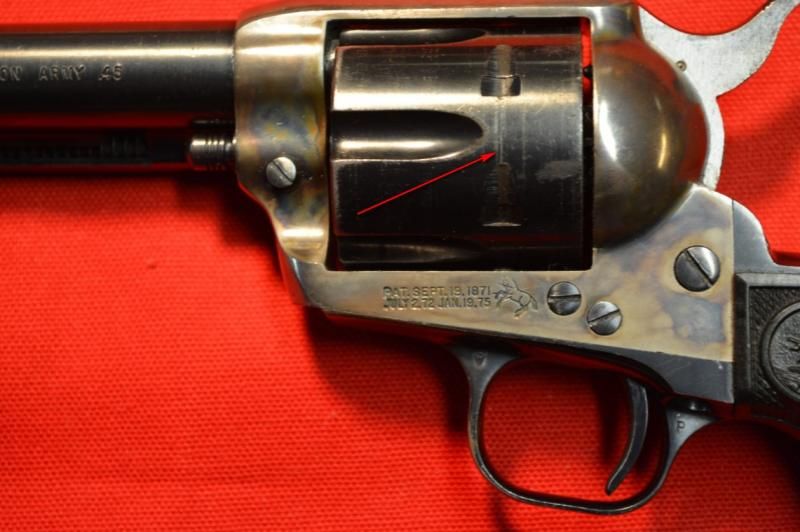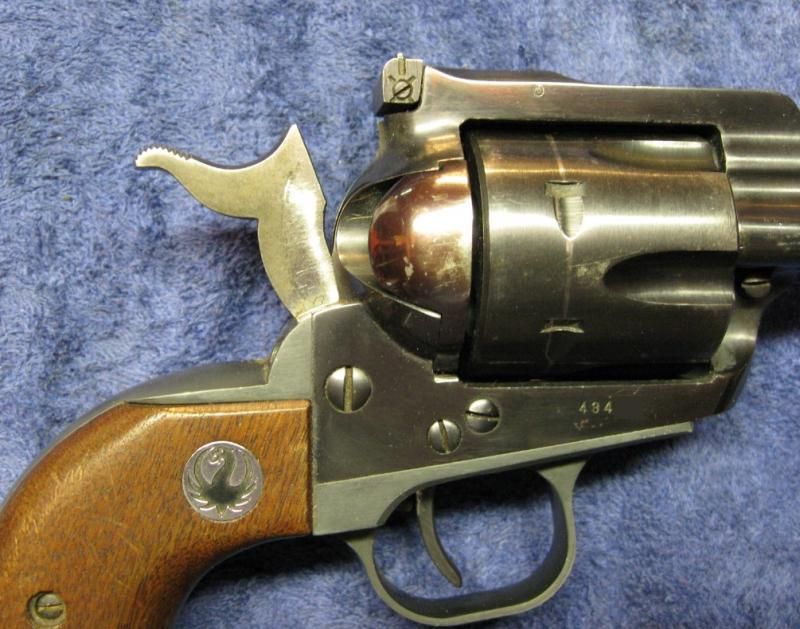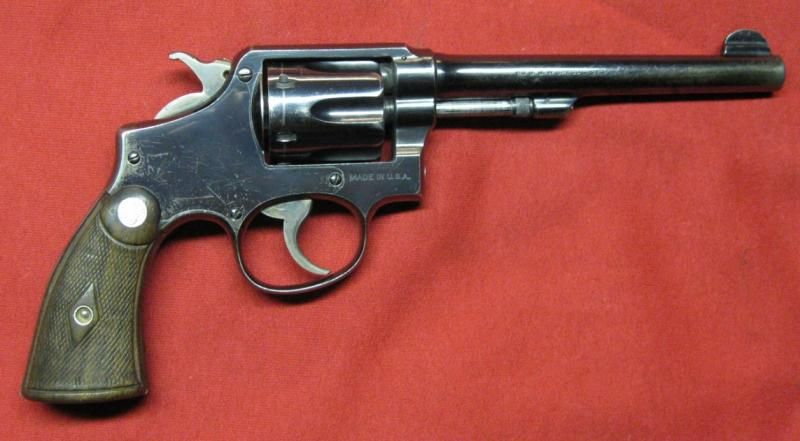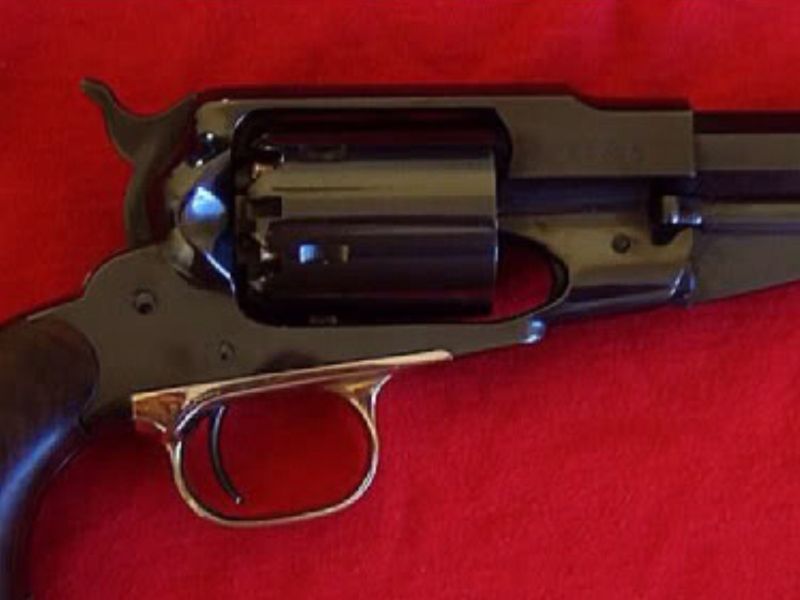Howdy
Oh my goodness. First of all, the revolver in question by the OP probably has a 'turn line'. An unturned cylinder is just about impossible to have, since at the factory when they are being built the cylinder will be turned all throughout the assembly process, and again when it is being proofed. Even if somebody buys a revolver brand, spanky new and never fires it, the cylinder will have been turned at some point. This is a very common error in terminology.
Now lets talk about Turn Lines. Here are some photos that will help clarify the issue.
First off is a 2nd Gen Colt with a turn line. The arrow points to the turn line. Notice it runs through the center of the cylinder locking notches and their related lead ins. With all due respect to Jim K, who obviously knows a lot about revolvers, this turn line is the result of the gun not being operated properly. The only way to load a revolver like this is to put the hammer at the half cock position. With the hammer at the half cock position, the bolt (the part that locks the cylinder in battery) will have withdrawn into the frame, allowing the cylinder to rotate freely for loading and unloading. The bolt has been pulled down because when the hammer is pulled back, the cam on the hammer rotates up, and it engages the tail end of the bolt, rotating the rear of the bolt up and the business end of the bolt down. So far everything is fine, we can unload and reload the revolver, or charge a Cap & Ball and put caps on the nipples.
The natural tendency at this point is to simply lower the hammer from half cock so we can shoot the gun. This is a mistake. Lowering the hammer from half cock allows the bolt to rise again, and spring pressure keeps the bolt pressing against the cylinder. Any inadvertent subsequent rotation of the cylinder, by hand or by accident, allows the bolt to rub against the cylinder. Do it enough times and the bolt rubs a Turn Line against the cylinder.
The correct way to load a single action revolver with a Colt style lockwork is to pull the hammer all the way back to full cock after one is done loading, then carefully lower the hammer. Doing this allows the cam to complete its cycle against the bolt. The cam rises all the way and the tail of the bolt slips off the cam, popping the business end up against the cylinder. A properly timed revolver will allow the bolt to pop up against the cylinder in the lead in to the locking notch. As the hammer continues to be pulled all the way to full cock, the cylinder continues to rotate and the bolt rubs against the lead in until it pops up into the locking notch. Finally, lowering the hammer allows the springy tail of the bolt to bend as the cam passes it by, leaving the business end of the bolt up and keeping the cylinder locked in battery. A well used, properly timed single action revolver with a Colt style lockwork will exhibit a short rub line about halfway into the lead in extending to the locking notch. That is completely normal.
I will only say that I bought this particular Colt used, and the rub line and other marks on the cylinder occurred before I owned it. That's my story and I'm sticking to it.
Let's leave the discussion about hammer down on an empty chamber for another time.

Here is a Ruger Blackhawk. Notice it has a Turn Line. A Turn Line such as this is completely normal on a Ruger. The lockwork of a New Model Blackhawk is completely different than the lockwork in a Colt. There is no half cock position to load from. Only full cock, or all the way down. Opening the loading gate pulls the bolt down into the frame, allowing the cylinder to turn for loading and unloading, closing the gate allows the bolt to press against the cylinder again. When we finish loading the Ruger, the cylinder will be out of battery. One of the chambers will be lined up with the loading gate and no chambers will be lined up with the bore. Rotating the cylinder, either by hand or by pulling back the hammer will allow the bolt to rub against the cylinder. Even if we carefully realign the cylinder with a chamber lined up with the bore before we close the loading gate, and I can assure you nobody does that, we will still get a Turn Line. That is because the timing is factory set on a Ruger to pop the bolt up early, about halfway between chambers, causing a Turn Line that runs from about halfway way between the chambers to the bolt stop, exactly as you see on my Black Hawk. That is the way they come from the factory. You could almost call a Turn Line a feature on a New Model Ruger.

While we're on the subject, here is an old Three Screw Ruger Blackhawk with a pretty severe Turn Line. These guns had a lockwork very similar to a Colt. They loaded from half cock, and if you didn't pull the hammer back all the way and lower it after loading, you got a Turn Line just like this.

Lastly, although it really does not belong in the Black Powder and Cowboy Action Shooting sub forum, lets look at a typical Smith and Wesson revolver to round out the discussion about Turn Rings. This 38 M&P was made in 1934. It has a fair amount of wear on it, including a very prominent Turn Ring. But it does not matter if it was made in 1905 or yesterday, all modern S&W revolvers will eventually get a turn line if they are shot at all. The lockwork inside one of these is radically different from any of the guns we have looked at so far. The bolt (Smith likes to call it the Cylinder Stop) is always being pushed up by its spring. The only time the bolt is withdrawn into the frame is as the the trigger rotates back, either in single action or double action, a nib at the front of the trigger pulls the bolt down. When the trigger rotates far enough, the nib lets go of the bolt and it pops up against the cylinder again. This happens long before the cylinder has rotated all the way for a new chamber to line up with the bore, and the bolt rubs against the cylinder for about half of the cycle. Completely normal, it is part of the design. Since it is a side swing cylinder, when the cylinder is swung out for loading the bolt is still in the up position. When the cylinder is closed again, it will be closed against the raised bolt, again completely normal, it is part of the design. I have heard tell of some who claim they carefully line up the cylinder when closing the gun so the bolt will pop into one of the locking notches. I don't know anyone who does that, I certainly don't, it is much, much less convenient than pulling the hammer back on a single action revolver. Even if one did this, the bolt will still pop up early every time the hammer is cocked or the trigger is pulled, and over time you will still get a Turn Line.

Bottom line, I expect the replica Walker Colt in the OP's question has a Turn Line from not pulling the hammer back and lowering it from the half cock position. Does it hurt the value? No, it is only a reproduction and very few actually collect these revolvers and try to keep them pristine. If it were mine and I bought it new would it eventually get a Turn Line? No, because I would pull the hammer back and lower it on an empty nipple after loading. Do the originals have Turn Lines? Seeing as there were only 1100 Walkers ever made, and some of them blew up from the heavy powder load in the iron cylinders, and the rest have probably been heavily used in the 168 years since they were made, probably. Does a Turn Line affect the value of an original Walker? Not one bit. They are one of the rarest guns ever made. General overall condition will affect its value, but a Turn Line is a minor component of overall condition.





